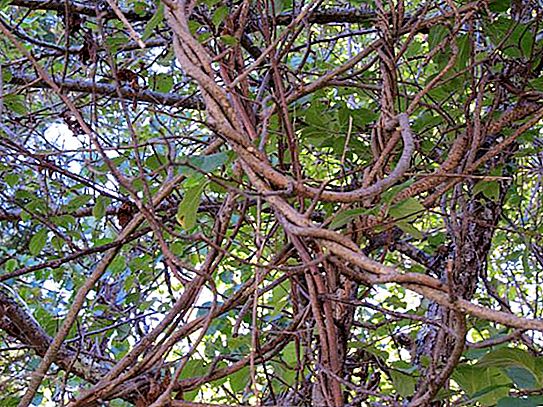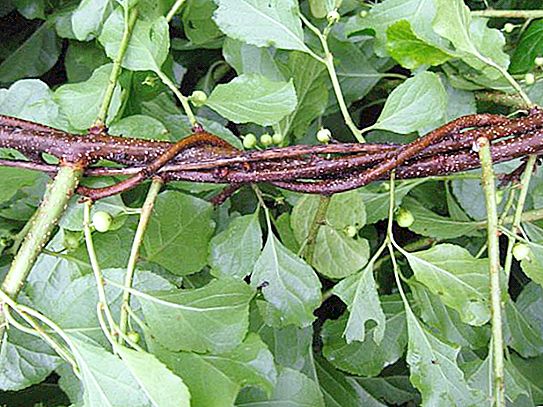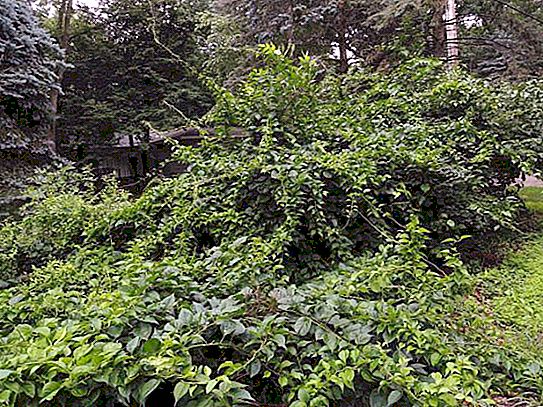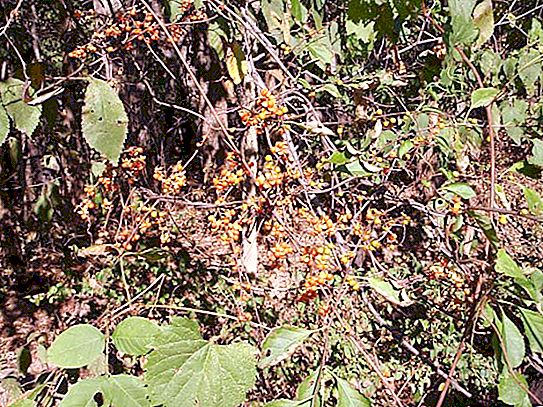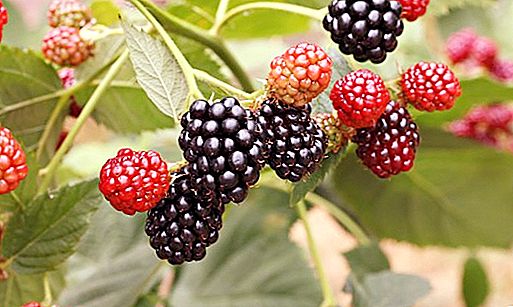The wood-cutter is a decorative vine with picturesque fruits, with small requirements for care and fairly rapid growth. This article provides information about the cultivation and care, the types of wood pliers.

Where did such a strange name for the plant come from?
This frightening name was given to the deciduous liana for the ability of its sickle-shaped hooks to grow into the trunk or branches of a tree, braid them and literally strangle plants with their arms until they die. Therefore, a round-leaved pliers is not recommended to be planted near valuable garden trees, such as:
- Apple tree.
- Pear.
- Plum.
- Apricot and others
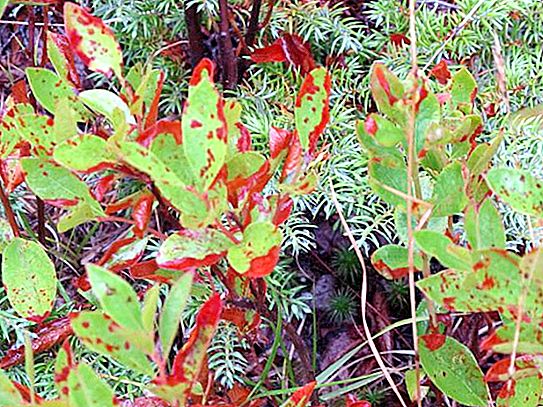
Description of the pliers
It is a fast-growing vine, deciduous and evergreen. This is a very large species of this plant, reaches a length of 12-18 meters. Liana stems cling to any support, braiding it and each other. In the upper part of the plant, a strongly branched crown is formed, in diameter it reaches 3 meters. If there are no supports, the round-leaved pliers (Celastrus orbiculatus) will spread along the ground, forming huge impenetrable thickets with their branches. The stems of adult plants are usually 1 to 4 cm in diameter. Shoots can be long and curly. There are not enough leaves on them, but on short and straight shoots of leaves there are a lot.
The bark of the stems is dark, with deep longitudinal cracks. The young shoots of the wood pliers first have a green color, and then they become orange-red or brownish-brown. The creeper wood is solid whitish-yellow, with a brown core in the middle.
The round-leaved pliers have dense, bright green, rounded and oblong leaves with a pointed tip of 5-10 cm in length and the same size in width. In autumn, the foliage acquires a bright yellow-orange color.
The woody liana blooms in June-July with nondescript greenish (whitish or pinkish) flowers. 8 days after the start, fruits are formed in the shape of a spherical box. It was at this time - during the fruiting period - that the unpretentious vine was especially effective and good.
At the end of August, the boxes turn bright yellow. And then they open in a very unusual way - with three wings. They hang on long stalks and show bright red fleshy seeds. They do not crumble even in winter and stand out beautifully among the snowy branches. Because of these seeds, the pliers have another name - the red bubble. Each box has 3 seeds. By the way, the seeds have germinated for 3 years. The fruits of the wood-cutter are enjoyed by birds in the autumn-winter period. The liana grows quickly enough - from 1 to 5 meters per year.
Wood pliers
The plant is widely used in landscape design and has great potential in this direction. In the summer, a liana is a wonderful background for a flower garden and pleases with its green leaves. In the autumn, the pliers are full of bright colors. In winter, branches with beautiful seeds are often used to compose various compositions, bouquets, flower arrangements. Very often, the circular pliers Hercules is used for vertical gardening. It perfectly decorates nondescript buildings, as well as:
- Fencing.
- Pergolas.
- Arches and others
A tree liana is often used as a cover for soils on slopes, embankments, and retaining walls. Preparations from seeds, roots, leaves and shoots of wood pliers are used in Chinese traditional medicine to treat various diseases.
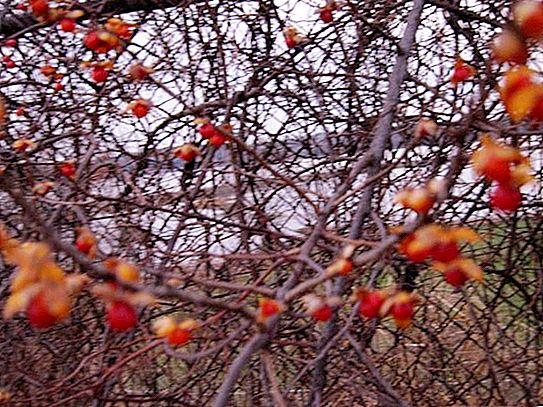
Homeland of the plant
In Russia, in its natural habitat, a woody vine (wood pliers) is found in the Primorsky Territory and on Sakhalin. The homeland of the wood pliers are:
- Equatorial and South Africa.
- Central America.
- Southeast Asia.
The most common this type of vines in a narrow strip of the sea coast and in river valleys, as well as:
- In sparse forests.
- Shrub thickets on sand and gravel deposits.
- Rocky and rocky slopes.
Plant species
The wood pliers are resistant to various diseases and are practically not attacked by pests.
Several types of plants are grown, these are:
- Brush-shaped.
- Round-leaved. Seeds of this type (for example, such as the pliers rotundifolia Monarch) can be ordered on specialized sites.
- Braided.
- Climbing.
- Curly.
- Tenacious.
In Russia, only 2 types of frost-resistant tree-like creepers are common - it is tenacious and round-leaved. Outwardly, these two species are almost no different.
Care
This frost-resistant look does not require shelter in winter. But sometimes young shoots in severe frost can freeze. Although subsequently easily depart and recover. The round-leaved pliers tolerate a transplant in spring and autumn very well, especially if he is 2-3 years old. The crown of the liana, especially if it has grown greatly, can be thinned, while removing dried branches and stems. The plant grows well both in partial shade and in the sun.
Tree liana propagation
The plant propagates both by seeds and by cuttings. Seeds can be sown immediately after their ripening in the fall. Spring (April) is also a wonderful time to plant a circular pliers. Plant growth is as follows. Seeds before spring planting are quenched for 2 months at a temperature of 2-5 degrees or kept in wet sand for 30 days. Seedlings already begin to emerge in May, by autumn, seedlings will reach a height of about 80 cm.
The first 3 years are the most dangerous for young plants. So that they do not freeze, seedlings must be sheltered from severe frosts. For the first time, a wood-plaster blooms only at 7 years old. Cuttings of vines are carried out in early spring. Semi-lignified shoots are suitable for cuttings. Cuttings 7 cm long are planted at an angle to the soil as a whole. After a month, the first shoots and roots appear. For winter, young plants also need to be sheltered.
Seedlings in the nursery are grown for 4 years, then sold. If there is a desire to buy a round-leaved pliers, it is best to choose a plant grown in a trusted nursery. After 4 years, this plant will already bloom.
If seedlings are planted in a row, then the distance between them should be about 1 meter. The soil is prepared as follows. Drainage is pouring at the bottom of the pit - sand, gravel, karamzit. Nutrient soil is then poured.
Liana loves loose soil. Therefore, the ground under it must be regularly loosened. In spring, the plant can be fertilized. In summer, in dry weather, the round-leaved pliers require plentiful watering. When planting this plant, you must immediately take care of its support.
The pliers can grow on any soil, also on dry. It would be better if the plant was planted in “poor” soil, since it grows very much on fertile lands. The tree-like liana perfectly adapts to acid soil.


